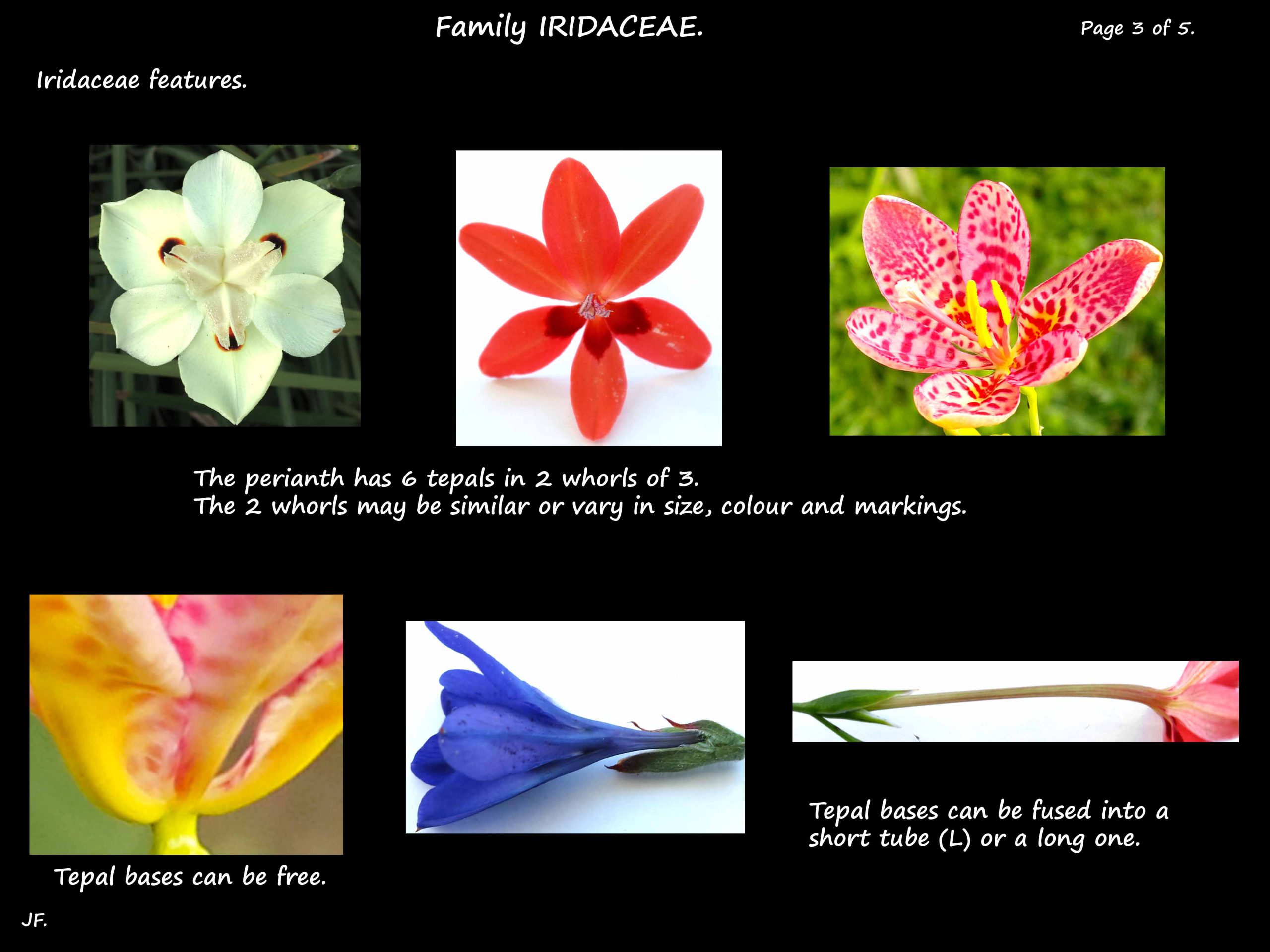Iridaceae.
There are 66 to 80 genera with 1500 to over 2000 species in the family.
Genera include Aristea, Babiana, Crocosmia, Crocus, Dietes, Freesia, Gladiolus,
Iris, Ixia, Sparaxis, Tritonia and Watsonia.
Some have been, or are still, used as garden ornamentals and cut flowers.
Others, such as Sparaxis and Watsonia are weeds.
There are about 25 genera in Australia with 50 to 100 species that are naturalised.
There are 5 genera native to Australia.
Plants are evergreen or deciduous and mostly perennial.
The stems are underground rhizomes, corms or occasionally bulbs.
In some the sheathing leaf bases form an above ground pseudostem.
Leaves are alternate in 2 ranks (distichous) with overlapping bases that sheath the stem.
The sheath margins may be fused or free.
Many have vertical, mostly linear or sword-shaped leaves forming a basal fan.
Some have needle-like leaves that are round in cross section.
The veins are parallel and some have a thickened midrib.
Terminal inflorescences can be a solitary flower or clusters on a spike.
Inflorescences may branch and each branch has a spathe-like bract at the base.
The individual flowers have 1 or 2 bracts under them.
Flowers are bisexual and nectar may be secreted from the tepal bases or the ovary.
The perianth has 6 members in 2 whorls of 3.
They may all be similar (petaloid tepals) or differentiated into sepals and petals.
The differentiation can be by colour or size with the upper ones being larger.
Tepals are often brightly coloured with various markings.
Commonly the 2 whorls are fused at the base into a long or short perianth tube.
Some species have a hypanthium.
Occasionally the inner whorl is greatly reduced in size.
There are 3 (2) stamens.
When separate they are opposite the outer tepals.
Alternately their bases may be fused with the stamens clustered together off centre.
Where there is a perianth tube the stamens insert onto the top.
The basifixed anthers open outwards mostly via longitudinal slits.
The ovary is inferior in all but 1 species (Isophysis).
It has 3 fused carpels and 3 locules each with a few to many ovules.
Placentation is mostly axile.
The single style usually has 3 branches which themselves may be forked.
The styles can be slender or wide and petaloid.
The fruit are loculicidal capsules.
Seeds are often angled and may be winged.
At present the family is divided into 4 subfamilies.
1. Subfamily Crocoideae has 3 tribes.
a. Pillansieae with 1 genus.
b. Watsonieae have flowers in spikes and deeply divided style-branches.
c. Ixeae includes some of the better known genera such as Babiana, Crocosmia, Crocus,
Freesia, Gladiolus, Ixia, Sparaxis and Tritonia.
2. Subfamily Iridoideae.
A large subfamily with 4 tribes – Irideae (Iris), Mariceae, Sisyrinchieae and Tigridieae.
3. Subfamily Isophysidoideae only has the Tasmanian genus Isophysis with a superior ovary.
4. Subfamily Nivenioideae (Geosiridaceae) with 6 or 7 genera including Aristea.
There are variations to this classification.
J.F.







